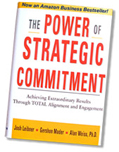
There are many different approaches organizations take to crafting a vision. They can initiate the process by taking a look at their mission and extrapolating from there. They can choose stretch objectives as their vision or focus on strategic intent; big, hairy, audacious goals or numerous other jumping-off points. While any of these can be useful, the aim is to simplify the process by asking three very straightforward questions.
First, what is unique about what you do? It’s key to identify the distinctive elements of your organization. For example, you don’t want to say something any other organization might say, such as, We’re going to offer first-class service, and our customers will be 100% satisfied. That vague type of vision could fit both a bank and a bakery, but it doesn’t uniquely identify what you have to offer.
Specific doesn’t have to mean complex. For example, way back when, Lexus’ vision was: Beat Benz. Those two words implied a vision that encompassed quality, sales and customer satisfaction.
Second, what distinguishes the level to or manner in which you provide your product or services? What you do as an organization may not be that unique. The retail banking at Bank of America, Citibank or Wells Fargo probably isn’t radically different from that of any other bank. You go into a bank, you get your money, you deposit your money.
What can be different is the level to or manner in which the product is provided. Nordstrom may sell the same suits as Bloomingdale’s — but Nordstrom distinguishes itself in service. Service, efficiency, quality and speed are some key elements that allow organizations to differentiate themselves, regardless of the competition.
Third, what is special about your internal culture? What is unique about the way people in your organization interact with one another? What do you do culturally that others in your industry don’t? For example, Starbucks has a culture that emphasizes making their baristas feel like they’re a key part of their organization — not just brewing coffee.
So, those three questions provide some real focus in crafting a clean, simple, concise vision statement.
One thing to keep in mind is that the questions are answered at a future point in time. It’s not a report about how we do it today; it’s an aspirational statement that is crafted as a declaration for two to three years down the road.
Also, it’s important to include a few simple, clear metrics. Few is the key word here: 58 performance measures are unmanageable, but five or six metrics that line right up to the vision seem doable and within reach. When everyone can link their day-to-day work to those five or six metrics, and thus to the vision, it’s alive, compelling and provides impetus to continue improving the organization.
What approach did you use in crafting the vision for your organization? Would you do it the same way next time? We would love to hear your comments.

